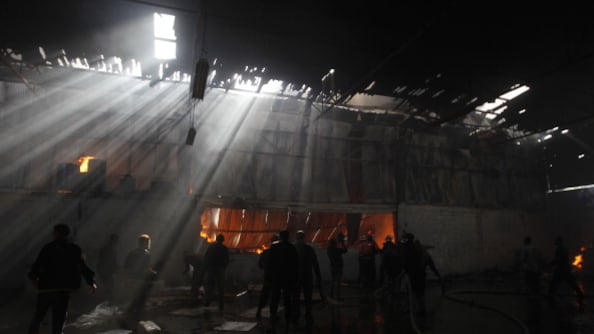Ayah Abu Basheer is a lecturer at the Islamic University in Gaza City. On Tuesday, as she was returning to her home in Deir El-Ballah, she heard loud, continuous explosions coming from the sky. “It rocked and shook my house completely,” she wrote to me. “I cannot finish this e-mail because the explosions are coming closer and closer to my home.”
Now, the Israeli airstrikes on the Gaza Strip are in their third day. At this point, the Israeli Air Forces (IAF) has conducted more than 466 airstrikes, bringing the reported Palestinian death toll to 41, and the total injured to more than 400. Ordinary Palestinians in Gaza like Abu Basheer face frequent power cuts—some for as long as twelve hours a day—while they stay inside, unable to leave their homes for fear of possibly deadly explosions. “We are used to the sounds of drones and bombings, but this time—due to the amount of deaths and injuries—we feel as we felt four years ago, during Operation Cast Lead," she wrote. "We don’t want to be alone.”

Almost exactly four years ago, Cast Lead rocked the Strip. That Israeli offensive, which came, like the latest air strikes, in response to stepped-up Palestinian militants' rocket attacks, left more than 1,400 Palestinians and thirteen Israelis dead. Over the course of three weeks, 3,500 homes were destroyed and 2,800 were significantly damaged. Tens of thousands were left without homes in a region where half a million members of the population already live in refugee camps.
Though Israel formally withdrew from the Gaza Strip in 2005, it's still considered by the U.S. and U.N. to be occupied because of Israeli control over its land and sea borders (save with Egypt) and airspace. Hamas took the reins of Palestinian government through a democratic election in 2006—incurring sanctions—but seized power violently in a pre-emptive counter-coup in 2007.
That's when Israel effectively closed the borders of Gaza for security—creating what many have referred to as an "open air prison" within Gaza's borders. As part of the blockade, Israel has complete control over all of Gaza's formal imports and exports, and doesn't allow imports of any materials that could conceivably be used by Hamas to make weapons that would threaten Israeli security.
Practically, this means that essential materials needed for reconstruction, such as concrete and iron, are barred from entering the country—meaning that even four years since Operation Cast Lead, most of Gaza’s infrastructure remains in war-torn disrepair.
Though after months of international pressure Israel slightly eased the blockade, it was not nearly adequate to restore the destruction that Operation Cast Lead wrought on the region. Hospitals and schools were leveled to the ground. Seven out of twelve power lines were toppled, leaving many without electricity for months. Sewage treatment plants were destroyed, contaminating the water and polluting the air. Many could barely function—much less return back to the normalcy of Gaza simply under siege.
Today, the violence is too immediate to begin to assess the inevitable damage to Gaza’s infrastructure. Al Shifa Hospital—the most central, and now one of the only operational hospitals in the Gaza Strip—is overwhelmed with a constant influx of injured patients in need of immediate urgent care. Due to the blockade, the hospital already lacks vital medicines, antibiotics, IV fluid, anesthesia and spare parts of medical equipment. In the event of a power outage, the hospital runs on fuel-powered generators—which even without a fuel shortage can only keep the hospital operational for one week.






